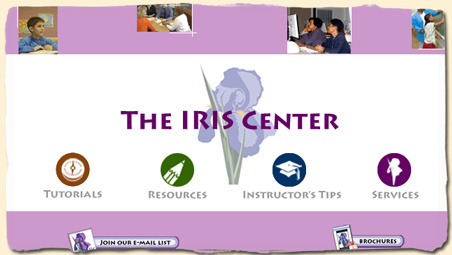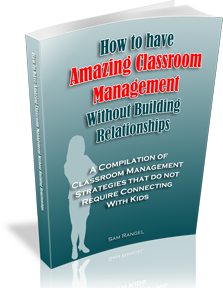
Today I spent the day at my Alma Mater, Claremont Graduate University. They had a workshop for Master Teachers, to better prepare us for when we have student teachers in our classrooms next year.
Today’s topic was classroom management. This seems to be the biggest problem that student teachers face in those early years. That’s why many teachers leave the profession after 3 years.
Without classroom management, students can’t learn, the teacher gets frustrated, and eventually loses his/her love for the job.
I was very impressed with the session, because it introduced me to a great resource called the Iris Center.
One of its founders, Dr. Deb Smith, was there to walk us through the program and its website.
I enthusiastically recommend that any new teacher or student teacher looking to improve their classroom management skills take a look at this site, and especially the section on classroom management.
Each section has modules that take you through a classroom scenario, then gives expert advice on how to handle these situations.
I went through the module called: Addressing Disruptive and Noncompliant Behaviors (Part 1): Understanding the Acting-Out Cycle.
In this module, experts discuss what to do when you have that student who is really defiant, the cuss-you-out-in-class student. Unfortunately, you will have those. Thankfully, I haven’t had to deal with such an incident in a while, but I noticed that as I was going through the module, many of the preventative measures mentioned are exactly those that I have incorporated in my teaching style. Yay!
Here is a little of what I found in the module:
1. There is an “acting-out cycle” with several stages that if you can recognize these stages, you will be able to “interrupt” the cyle.
2. The phases to the cycle are: 1. Calm 2. Triggers 3. Agitation 4. Acceleration 5. Peak 6. De-Escalation and 7. Recovery.
3. There are actions that the teacher can take at each phase that can either prevent the student from acting out or understand why it happened and make it a teachable moment.
Here’s a quick, very quick, summary of what I learned about the different phases:
1. The Calm Phase
Your goal as a teacher is to keep students in this phase. This is maintained by having structure to your classroom, making it a point to teach the students how to treat each other with respect, and giving students your attention. That is, show sincere concern for each student, especially for that student who may be easily pushed to that “acting-out” stage.
2. The Triggers Phase
What is that event that will cause the student to leave the calm phase? It could be an argument with a peer, a negative exchage with the teacher, a poor grade on an assignment, even an inability to do the work. Sometimes, it can be a non-school related trigger like problems at home, lack of sleep, a medical issue, etc. Recognizing these triggers early on, and taking action to address these needs, will allow the teacher to interrupt the cycle. The module offers ideas on how to do this.
3. The Agitation Phase
This is what I call the “just about to blow” phase. The student starts fidgeting, tapping his/her pencil, looking around, etc. Again, being able to move in and offer calming alternatives to this behavior will help the teacher keep the student from moving to the next phase.
4. The Acceleration Phase
This is where the student actually begins to interact with the teacher by making inappropriate comments, like “This is boring.” Here is where the teacher has the biggest effect on the situation. I’ve heard teachers answer the student with a sarcastic reply that only makes things worse. I did this when I was younger, and I learned the lesson the hard way. A teacher’s response at this stage is critical. It will determine if the student will calm down or explode. The best response, I’ve learned, is to NOT get into an argument with a kid. There’s a point where the teacher has to swallow his/her pride to prevent World War 3. The module states, “It’s one of those lose the battle to win the war moments.” I totally agree.
5. The Peak Phase
This is World War 3. The student is yelling at you, cussing you out, throwing tables, etc. It’s bad. Here, the most important thing is to keep the other students safe. Find out what the policy is at your school for such incidents. Do you call the administrator? Do you tell the other kids to line up outside the door? Find out. Hopefully, it won’t happen, but find out just in case.
6. The De-Escalation Phase
The earthquake has stopped. Now what? The main point the module is that you have to treat the student with dignity. They don’t want to talk about it right at the moment, so let them “cool down” in another room or away from the rest of the students (assuming the security officer hasn’t already taken them to the office.)
7. The Recovery Phase
This is your teachable moment time. Once the student has settled down, this is the time when the teacher needs to discuss the blow up with the student. It’s important that this meeting take place, otherwise, the student may think that he/she can get away with that behavior. Here is where the teacher can find out more about what underlying situations may be causing the behavior.
It was enlightening to see how the behavior of that out of control student can be divided into phases. Once the teacher recognizes the phases, then he/she can take action to keep the student from reaching the “peak” of disruption.
Again, I was very impressed with the web site. There is a wealth of great information and resources that I know I’ll be mentioning in future posts.
The site is easy to navigate, loaded with tips and strategies to use in probably every classroom situation, video clips of classroom scenarios, and so much more… and it’s all free!
I’m still learning all that the site has to offer. I’ll share more in future posts.
Take a look. Let me know what you think. Tell your staff about it. It’s that good.
Here’s the link: www.IrisCenter.com.
Special thanks to Dr. Smith of Claremont Graduate Univeristy and the Iris Center.
Talk to you soon,
Sam



